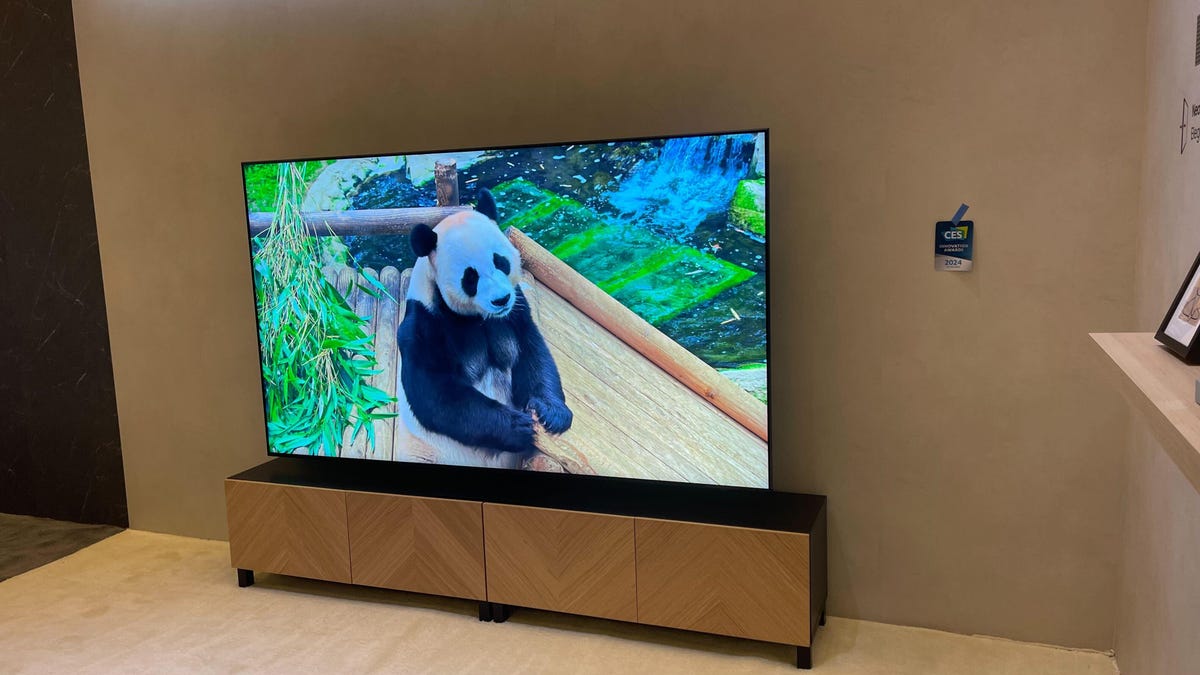Samsung has sold more TVs than any other brand for more than 15 years, and at CES 2024, the company introduced TVs that use both OLED and QLED technology. For the QLED-powered models I’ll describe here, the main picture quality and design innovations are reserved for its TVs with 8K resolution.
The flagship QN900D is billed by Samsung as the slimmest, most premium 8K TV to ever hit the market. Available from 65 to 98 inches, it has a mirrored “floating” stand and a compact, U-shaped One Connect box to connect your gear. Image quality is powered by a mini-LED backlight and beefed-up processing, including an AI Motion Enhancer Pro to improve fast-moving objects and the ability to upscale low-resolution, standard-def content to 8K, which Samsung claims is a first.
Samsung also says the 900D is the first TV to support a maximum variable refresh rate (VRR) of 240Hz, improving the smoothness of games. Most other TVs max out at 120Hz or 144Hz, although Samsung’s step-down 800D 8K TV can go up to 165Hz. Note that these higher refresh rates work only with PCs, not game consoles like Xbox Series X or PlayStation 5, so I don’t consider them a big deal for most people.

4K and 98-inch screens x4
Samsung claims that nearly 40% of high-end buyers are considering an 8K TV, but I still don’t think they’re worth the high price for most people. The company also introduced two high-end Neo QLED 4K models as well, the QN85D and QN90D, available in sizes from 43 to 98 inches and also offering mini-LED backlights. A new Custom Picture Mode shows you a set of four AI-generated images and uses the one you choose to adjust the image.
I didn’t review any Samsung New QLED TVs last year, but judging from the specifications, I’d expect the QN90D to perform at roughly the same level as the QN90B, one of my favorite non-OLED TVs in 2022.
Huge TVs are a big deal at CES, and while Samsung doesn’t have any mainstream models over 100 inches, it will sell four separate series in 2024 that offer a 98-inch size, including a 98-inch version of its affordable Crystal UHD series. True to form, the company created SuperSize Picture Enhancer designed to enhance sharpness and black levels on large screens.
Gaming and accessibility extras
I’m a fan of Samsung’s Game Bar, which offers easy access to gaming stats like VRR as well as dedicated picture settings. The 2024 version, Game Bar 4.0, adds the ability to automatically detect a game genre, like role-playing, shooters or sports, and switch the game picture setting automatically. (Of course, Samsung calls it AI Auto Setting.) The system can also automatically detect the in-game mini-map to move it to another part of the screen. The Gaming Hub, which can access cloud games including Xbox, has a “tailored UI curated for you and your personal gaming preferences,” according to Samsung.
One cool new accessibility feature called Audio Subtitles recognizes the subtitles at the bottom of the screen and can actually read them out loud in real time, using text-to-speech technology. Last year, Samsung introduced an accessibility feature called Relumino, which improves contrast and sharpness for people with low vision. This year, you can use a split screen to watch normal video on one side and Relumino on the other.
Samsung also announced two series of OLED-based TVs. It didn’t announce pricing on any of its new TVs at CES. The new models will likely start shipping in spring, and I’ll know more once I get the chance to review them in person after that.
